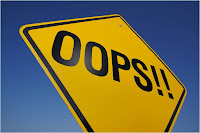by Gilda Bonanno http://www.gildabonanno.com/
It happens. Despite your preparation and practice, you make a mistake during your presentation. You quote the wrong statistic, mispronounce the product name or stumble over your words while providing an example. What do you do?
 First of all, remember that it seems worse to you than it does to the audience. In some cases, they didn't even notice your mistake. Don't call attention to it by stopping in mid-sentence, looking horrorstruck and apologizing profusely. Simply pause, take a breath, restate the statistic, word or phrase correctly and keep moving forward. There is no need to dwell on it or make a big deal out of it. Keep going with the rest of your presentation as planned.
First of all, remember that it seems worse to you than it does to the audience. In some cases, they didn't even notice your mistake. Don't call attention to it by stopping in mid-sentence, looking horrorstruck and apologizing profusely. Simply pause, take a breath, restate the statistic, word or phrase correctly and keep moving forward. There is no need to dwell on it or make a big deal out of it. Keep going with the rest of your presentation as planned.
Sometimes the mistake is obvious to everyone in the room and it's not small. For example, at a presentation early in my speaking career, I ended with a handout that misspelled the client company's name. I didn't realize it until I heard some laughs and someone in the audience pointed it out to me. I immediately turned the microphone back on and admitted that I had made a mistake spelling the company's name. I apologized and then made a humorous comment about needing to hire an assistant to proofread. It was such a glaring error that I could not ignore it; even if everyone hadn't noticed it yet, they would when they read the handout or when someone else made a joke about it. By taking responsibility for my mistake and apologizing, I was able to salvage the situation and no permanent damage was done. (And you can be sure that the experience taught me to triple-proofread my handouts, especially the company name!)
We are all human, which means that we make mistakes – how you handle your mistakes is what matters. When presenting, your goal is not to be perfect – that is unrealistic and unnecessary. Your goal is to communicate and that does not require perfection.
Gilda Bonanno's blog www.gildabonanno.blogspot.com
It happens. Despite your preparation and practice, you make a mistake during your presentation. You quote the wrong statistic, mispronounce the product name or stumble over your words while providing an example. What do you do?
 First of all, remember that it seems worse to you than it does to the audience. In some cases, they didn't even notice your mistake. Don't call attention to it by stopping in mid-sentence, looking horrorstruck and apologizing profusely. Simply pause, take a breath, restate the statistic, word or phrase correctly and keep moving forward. There is no need to dwell on it or make a big deal out of it. Keep going with the rest of your presentation as planned.
First of all, remember that it seems worse to you than it does to the audience. In some cases, they didn't even notice your mistake. Don't call attention to it by stopping in mid-sentence, looking horrorstruck and apologizing profusely. Simply pause, take a breath, restate the statistic, word or phrase correctly and keep moving forward. There is no need to dwell on it or make a big deal out of it. Keep going with the rest of your presentation as planned.Sometimes the mistake is obvious to everyone in the room and it's not small. For example, at a presentation early in my speaking career, I ended with a handout that misspelled the client company's name. I didn't realize it until I heard some laughs and someone in the audience pointed it out to me. I immediately turned the microphone back on and admitted that I had made a mistake spelling the company's name. I apologized and then made a humorous comment about needing to hire an assistant to proofread. It was such a glaring error that I could not ignore it; even if everyone hadn't noticed it yet, they would when they read the handout or when someone else made a joke about it. By taking responsibility for my mistake and apologizing, I was able to salvage the situation and no permanent damage was done. (And you can be sure that the experience taught me to triple-proofread my handouts, especially the company name!)
We are all human, which means that we make mistakes – how you handle your mistakes is what matters. When presenting, your goal is not to be perfect – that is unrealistic and unnecessary. Your goal is to communicate and that does not require perfection.
Gilda Bonanno's blog www.gildabonanno.blogspot.com